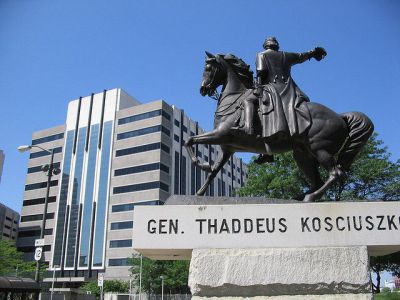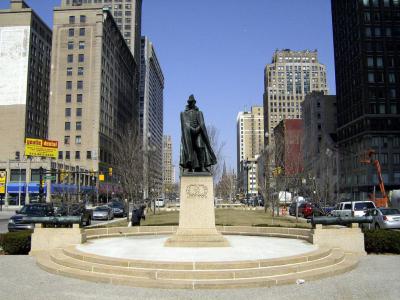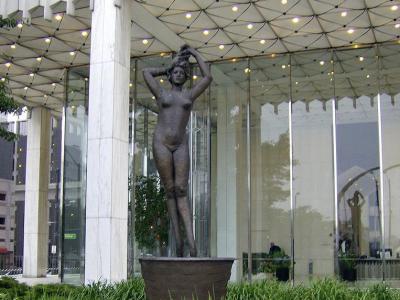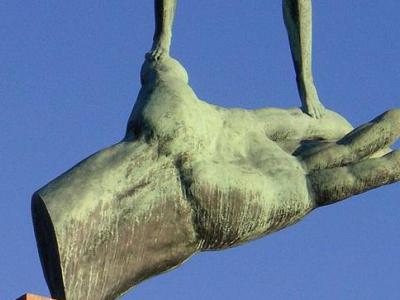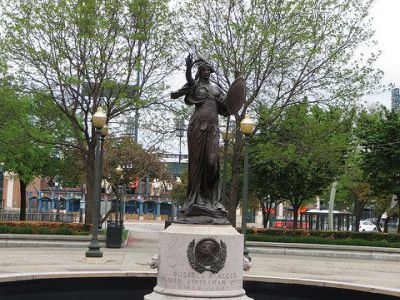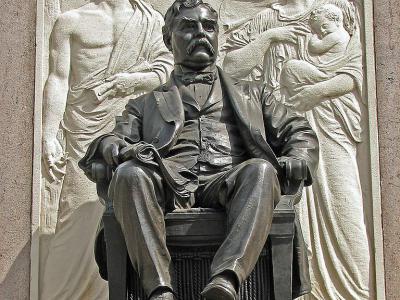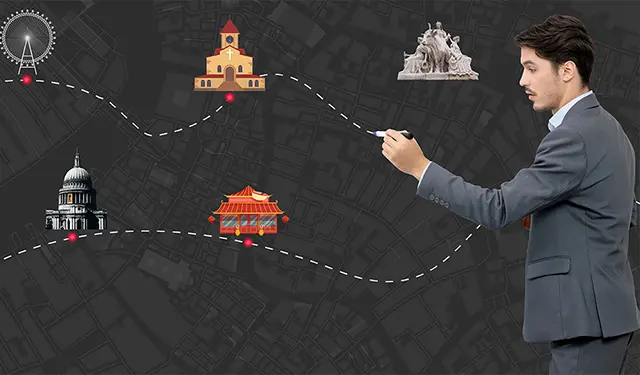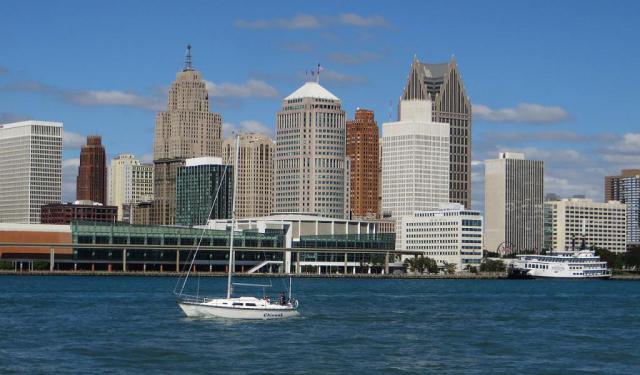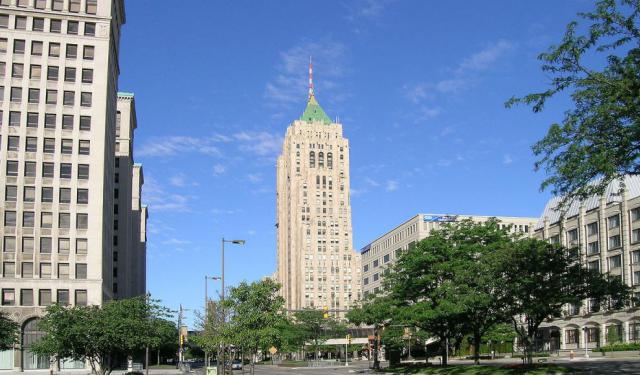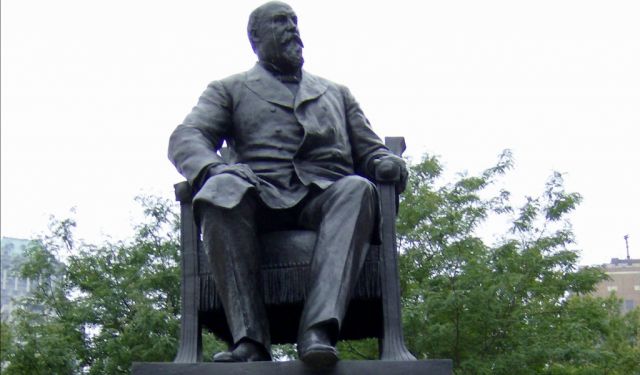
Monuments Tour (Self Guided), Detroit
Detroit is known for having many monuments and statues to great personalities that are scattered across the city.
Did you know that the monument commemorating the “freedom fighter for two continents”, Thaddeus Kosciuszko, is actually replica of the monument standing by Wawel castle in Krakow, Poland? Another featured military figure, Gen. Alexander Macomb, was a hero in the War of 1812 and longtime 19th century military leader in Detroit.
Flanked by bows of ships on either side, the monument to Christopher Columbus was dedicated in 1910, and was a gift from the readers of an Italian newspaper in honor of the 400th anniversary of Columbus' death.
Contrasting these male figures is a 11-foot bronze sculpture crafted by local artist, Giacomo Manzu, which depicts his wife as a nude ballet dancer, standing on point with her hands sensually uncoiling her hair above her head.
Similarly, the Russell A. Alger Memorial Fountain in Grand Circus Park features a bronze statue of a woman about 7 feet tall wearing a headdress and a flowing gown and carrying a sword and a shield that bears the state seal. She is the bronze personification of the state of Michigan!
Take our self-guided tour to explore these and other unique monuments and statues in Detroit.
Did you know that the monument commemorating the “freedom fighter for two continents”, Thaddeus Kosciuszko, is actually replica of the monument standing by Wawel castle in Krakow, Poland? Another featured military figure, Gen. Alexander Macomb, was a hero in the War of 1812 and longtime 19th century military leader in Detroit.
Flanked by bows of ships on either side, the monument to Christopher Columbus was dedicated in 1910, and was a gift from the readers of an Italian newspaper in honor of the 400th anniversary of Columbus' death.
Contrasting these male figures is a 11-foot bronze sculpture crafted by local artist, Giacomo Manzu, which depicts his wife as a nude ballet dancer, standing on point with her hands sensually uncoiling her hair above her head.
Similarly, the Russell A. Alger Memorial Fountain in Grand Circus Park features a bronze statue of a woman about 7 feet tall wearing a headdress and a flowing gown and carrying a sword and a shield that bears the state seal. She is the bronze personification of the state of Michigan!
Take our self-guided tour to explore these and other unique monuments and statues in Detroit.
How it works: Download the app "GPSmyCity: Walks in 1K+ Cities" from Apple App Store or Google Play Store to your mobile phone or tablet. The app turns your mobile device into a personal tour guide and its built-in GPS navigation functions guide you from one tour stop to next. The app works offline, so no data plan is needed when traveling abroad.
Monuments Tour Map
Guide Name: Monuments Tour
Guide Location: USA » Detroit (See other walking tours in Detroit)
Guide Type: Self-guided Walking Tour (Sightseeing)
# of Attractions: 6
Tour Duration: 2 Hour(s)
Travel Distance: 3.4 Km or 2.1 Miles
Author: vickyc
Sight(s) Featured in This Guide:
Guide Location: USA » Detroit (See other walking tours in Detroit)
Guide Type: Self-guided Walking Tour (Sightseeing)
# of Attractions: 6
Tour Duration: 2 Hour(s)
Travel Distance: 3.4 Km or 2.1 Miles
Author: vickyc
Sight(s) Featured in This Guide:
- General Thaddeus Kosciuszko
- Statue of General Alexander Macomb
- Passo di Danza (Step of the Dance)
- Hand of God
- Russell A. Alger Memorial
- Statues of Mayors Hazen S. Pingree and William C. Maybury
1) General Thaddeus Kosciuszko
The statue of General Thaddeus Kosciuszko in Detroit commemorates a Polish-American hero renowned for his contributions to the causes of freedom and human rights in both the United States and Poland. Thaddeus Kosciuszko (Tadeusz Kościuszko in Polish) was a military engineer, statesman, and national hero who played a pivotal role in the American Revolutionary War and later fought for Poland's independence.
Kosciuszko, born in 1746 in present-day Belarus, traveled to America in 1776 to support the Revolutionary War. As a skilled military engineer, he designed vital fortifications like those at West Point and contributed to key victories. A dedicated advocate for civil rights, he championed the freedom and education of enslaved people and fair treatment for Native Americans. After the war, he returned to Poland to fight for its independence, becoming a symbol of resistance to oppression.
The bronze equestrian statue in Detroit, erected in 1911, was a gift from Poland and is a replica of a monument in Krakow. The sculpture depicts Kosciuszko in military attire, often shown with elements like a sword to highlight his role as a tactician and leader. Mounted on a pedestal with inscriptions detailing his achievements, the statue honors his dedication to liberty and his lifelong fight against tyranny.
This memorial is not just a tribute to Kosciuszko’s remarkable life but also a celebration of the enduring ties between the United States and Poland. It symbolizes the shared values of freedom and self-determination, as well as the contributions of Polish Americans to Detroit’s cultural and historical fabric.
Kosciuszko, born in 1746 in present-day Belarus, traveled to America in 1776 to support the Revolutionary War. As a skilled military engineer, he designed vital fortifications like those at West Point and contributed to key victories. A dedicated advocate for civil rights, he championed the freedom and education of enslaved people and fair treatment for Native Americans. After the war, he returned to Poland to fight for its independence, becoming a symbol of resistance to oppression.
The bronze equestrian statue in Detroit, erected in 1911, was a gift from Poland and is a replica of a monument in Krakow. The sculpture depicts Kosciuszko in military attire, often shown with elements like a sword to highlight his role as a tactician and leader. Mounted on a pedestal with inscriptions detailing his achievements, the statue honors his dedication to liberty and his lifelong fight against tyranny.
This memorial is not just a tribute to Kosciuszko’s remarkable life but also a celebration of the enduring ties between the United States and Poland. It symbolizes the shared values of freedom and self-determination, as well as the contributions of Polish Americans to Detroit’s cultural and historical fabric.
2) Statue of General Alexander Macomb
The Statue of General Alexander Macomb is a monumental tribute located in Detroit, dedicated to one of the city's notable historical figures. Created by sculptor Adolph Alexander Weinman, the bronze statue was unveiled on September 11, 1908, to commemorate Alexander Macomb, a Detroit native and prominent military leader who served as the Commanding General of the United States Army from 1828 to 1841. The dedication date aligns with the anniversary of the Battle of Plattsburgh, a key conflict in the War of 1812 where Macomb's leadership earned him a Congressional Gold Medal.
The monument features a 9-foot-tall bronze statue of General Alexander Macomb in his War of 1812 uniform, with a hat and wind-blown cape, standing atop a 7-foot pink granite pedestal engraved with his name and military honors. The pedestal is adorned with oak and laurel wreaths and rests on a 30-foot circular concrete platform with granite steps, a rear parapet, and bronze cannons from the War of 1812 at three edges.
Born in Detroit in 1782, Macomb gained prominence for his military career, particularly in the Battle of Plattsburgh. After he died in 1841, his legacy faded until this statue was commissioned in 1908. In recent years, the statue has faced criticism for Macomb's ties to slavery and Native American mistreatment and was vandalized during the 2020 George Floyd protests amid reevaluations of historical figures.
Despite the criticisms, the Statue of General Alexander Macomb remains a significant part of Detroit's historical landscape, highlighting the city's connection to national events and military history. It continues to serve as a reminder of both Macomb's contributions and the evolving perspectives on historical commemoration.
The monument features a 9-foot-tall bronze statue of General Alexander Macomb in his War of 1812 uniform, with a hat and wind-blown cape, standing atop a 7-foot pink granite pedestal engraved with his name and military honors. The pedestal is adorned with oak and laurel wreaths and rests on a 30-foot circular concrete platform with granite steps, a rear parapet, and bronze cannons from the War of 1812 at three edges.
Born in Detroit in 1782, Macomb gained prominence for his military career, particularly in the Battle of Plattsburgh. After he died in 1841, his legacy faded until this statue was commissioned in 1908. In recent years, the statue has faced criticism for Macomb's ties to slavery and Native American mistreatment and was vandalized during the 2020 George Floyd protests amid reevaluations of historical figures.
Despite the criticisms, the Statue of General Alexander Macomb remains a significant part of Detroit's historical landscape, highlighting the city's connection to national events and military history. It continues to serve as a reminder of both Macomb's contributions and the evolving perspectives on historical commemoration.
3) Passo di Danza (Step of the Dance)
The Passo di Danza (Step of the Dance) is a breathtaking bronze sculpture by renowned Italian sculptor Giacomo Manzù, commissioned by architect Minoru Yamasaki for the Jefferson Avenue entrance of One Woodward Avenue. Crafted in the likeness of Manzù's wife, the statue captures the ethereal beauty of a ballet dancer poised delicately on her toes, her hands resting elegantly on her head as she prepares for the first step of her dance. The sculpture gleams in the sunlight, adding an air of sophistication and artistry to its surroundings.
Originally, the statue stood at the center of a reflecting pool adorned with gas torches, creating a dramatic interplay of fire and water. However, due to structural issues with the pool's base, much of it was replaced with greenery in the 1980s. Despite these changes, the Passo di Danza remains a striking feature of the office tower plaza, adding a touch of European elegance to Detroit's urban landscape.
Commissioned in 1962 for Minoru Yamasaki’s first skyscraper, One Woodward Avenue, the Passo di Danza graces the entrance of this 29-story modernist landmark, now home to Fifth Third Bank. Adding to its lore, pranksters once painted green footprints leading from the Spirit of Detroit to the sculpture, imagining a late-night visit.
The Passo di Danza stands near the Renaissance Center (RenCen), a cluster of skyscrapers that define Detroit’s skyline and house Michigan’s tallest building. This contrast between the timeless bronze sculpture and the modern RenCen reflects Detroit’s blend of history, culture, and innovation, showcasing the city’s artistic and architectural vibrancy.
Originally, the statue stood at the center of a reflecting pool adorned with gas torches, creating a dramatic interplay of fire and water. However, due to structural issues with the pool's base, much of it was replaced with greenery in the 1980s. Despite these changes, the Passo di Danza remains a striking feature of the office tower plaza, adding a touch of European elegance to Detroit's urban landscape.
Commissioned in 1962 for Minoru Yamasaki’s first skyscraper, One Woodward Avenue, the Passo di Danza graces the entrance of this 29-story modernist landmark, now home to Fifth Third Bank. Adding to its lore, pranksters once painted green footprints leading from the Spirit of Detroit to the sculpture, imagining a late-night visit.
The Passo di Danza stands near the Renaissance Center (RenCen), a cluster of skyscrapers that define Detroit’s skyline and house Michigan’s tallest building. This contrast between the timeless bronze sculpture and the modern RenCen reflects Detroit’s blend of history, culture, and innovation, showcasing the city’s artistic and architectural vibrancy.
4) Hand of God
The Hand of God is a monumental sculpture by Swedish sculptor Carl Milles, located outside Detroit's Frank Murphy Hall of Justice. It honors Frank Murphy, former mayor, Michigan governor, and Supreme Court justice, who championed workers’ rights during the Flint sit-down strike by protecting striking workers and mediating a resolution, a pivotal moment for U.S. labor unions.
The sculpture, cast in bronze and mounted on black granite, features a giant hand supporting a small, naked figure who leans backward while gazing upward, body tensed in a gesture that evokes strength, vulnerability, and aspiration. The composition conveys a sense of divine intervention, human potential, and the intricate relationship between humanity and higher forces.
Carl Milles worked on The Hand of God from 1949 to 1953, drawing inspiration from a dream and heavily influenced by his admiration for Auguste Renoir's focus on hands. The hand in the sculpture is modeled after Milles’ left hand. The piece was recast and donated to the city of Detroit in 1970 by the United Auto Workers (UAW) as a tribute to Murphy’s contributions to social justice and labor reform.
Detroit’s Hand of God is part of a global series, with the original in Eskilstuna, Sweden, honoring C. E. Johansson, a pioneer in industrial precision. Other versions are displayed in Indonesia, Japan, China, and as part of the Global Award for Entrepreneurship Research, each marked with a “Millesgarden” tag from the artist’s studio in Sweden.
The sculpture’s striking design and profound symbolism make it a fitting tribute to Murphy’s legacy and Detroit’s enduring connection to social progress and labor rights.
The sculpture, cast in bronze and mounted on black granite, features a giant hand supporting a small, naked figure who leans backward while gazing upward, body tensed in a gesture that evokes strength, vulnerability, and aspiration. The composition conveys a sense of divine intervention, human potential, and the intricate relationship between humanity and higher forces.
Carl Milles worked on The Hand of God from 1949 to 1953, drawing inspiration from a dream and heavily influenced by his admiration for Auguste Renoir's focus on hands. The hand in the sculpture is modeled after Milles’ left hand. The piece was recast and donated to the city of Detroit in 1970 by the United Auto Workers (UAW) as a tribute to Murphy’s contributions to social justice and labor reform.
Detroit’s Hand of God is part of a global series, with the original in Eskilstuna, Sweden, honoring C. E. Johansson, a pioneer in industrial precision. Other versions are displayed in Indonesia, Japan, China, and as part of the Global Award for Entrepreneurship Research, each marked with a “Millesgarden” tag from the artist’s studio in Sweden.
The sculpture’s striking design and profound symbolism make it a fitting tribute to Murphy’s legacy and Detroit’s enduring connection to social progress and labor rights.
5) Russell A. Alger Memorial
The Russell A. Alger Memorial Fountain, located on the east side of Detroit's Grand Circus Park, is a tribute to one of Michigan’s most notable figures, Russell A. Alger (1836–1907). Unveiled on July 27, 1921, the fountain is considered one of the most successful collaborations between sculptor Daniel Chester French and architect Henry Bacon, the duo renowned for designing the Lincoln Memorial in Washington, D.C.
The Beaux-Arts monument features a seven-foot bronze figure symbolizing Michigan, with one hand raised in greeting and the other holding a sword and shield bearing the state crest. A bas-relief of Alger, framed by laurel wreaths, adorns the base, which also has lion heads as water founts and the inscription: "Russell A. Alger — Soldier — Statesman — Citizen — 1836–1907."
Russell Alger, a Civil War veteran who rose to general, served as Michigan’s Governor (1885–1887), U.S. Senator, and Secretary of War under President McKinley. A successful lumber baron and railroad executive, he played a key role in Michigan's growth. After he died in 1907, Civil War veterans commissioned a memorial. Delays over its location were resolved, and the fountain was completed in Grand Circus Park in 1921.
Sculptor Daniel Chester French, famed for works like the Minute Man statue, and architect Henry Bacon, a master of classical monuments and 1923 AIA Gold Medal recipient, collaborated on the fountain. The Gorham Manufacturing Company cast the bronze statue, with Presbey-Leland Memorials as contractors.
Today, the Russell A. Alger Memorial Fountain stands as a testament to Alger’s legacy and the artistic brilliance of French and Bacon.
The Beaux-Arts monument features a seven-foot bronze figure symbolizing Michigan, with one hand raised in greeting and the other holding a sword and shield bearing the state crest. A bas-relief of Alger, framed by laurel wreaths, adorns the base, which also has lion heads as water founts and the inscription: "Russell A. Alger — Soldier — Statesman — Citizen — 1836–1907."
Russell Alger, a Civil War veteran who rose to general, served as Michigan’s Governor (1885–1887), U.S. Senator, and Secretary of War under President McKinley. A successful lumber baron and railroad executive, he played a key role in Michigan's growth. After he died in 1907, Civil War veterans commissioned a memorial. Delays over its location were resolved, and the fountain was completed in Grand Circus Park in 1921.
Sculptor Daniel Chester French, famed for works like the Minute Man statue, and architect Henry Bacon, a master of classical monuments and 1923 AIA Gold Medal recipient, collaborated on the fountain. The Gorham Manufacturing Company cast the bronze statue, with Presbey-Leland Memorials as contractors.
Today, the Russell A. Alger Memorial Fountain stands as a testament to Alger’s legacy and the artistic brilliance of French and Bacon.
6) Statues of Mayors Hazen S. Pingree and William C. Maybury
The statues of Mayors Hazen S. Pingree and William H. Maybury commemorate these civic leaders of Detroit. Their statues are located in Grand Circus Park near one another, but they were far from friends – instead, they were mortal enemies who "hated, detested, loathed each other," as the Free Press wrote in 1941.
Hazen S. Pingree served as Detroit mayor from 1890 to 1897, leaving office only after being elected governor of Michigan. Old Ping, as he was known, was named one of the 10 best mayors in U.S. history in a poll of scholars, who noted that his "role as an advanced social reformer was unmatched by any big-city mayor in the last half of the 19th century." His tough-love form of social reform, historians note, was the forerunner for the reforms of the Progressive Era. Besides his social reforms, the Republican mayor is best known for turning vacant land into vegetable patches to feed the city's needy during the economic downturn of the 1890s.
The mustachioed mayor kicking back next to him, William Cotter Maybury had previously been Detroit's city attorney and a congressman. He "won local, if not national, renown as a baby-kisser. He just cooed his way into office telling mothers how beautiful their babies were," the Free Press wrote in 1941. "For a while no mother thought her child would have a chance in life unless he had been kissed by dear Mr. Maybury – that nice, nice man." He did not make waves with Big Business and didn't continue Pingree's all-out fight for municipally owned utilities. He may have been timid, but Detroiters approved of Maybury's laid-back, relaxed style. Industry leaders were particular supporters of his pro-business philosophy toward government, and Maybury is to thank in part for the vast number of factories that began to dot the city under his watch.
Hazen S. Pingree served as Detroit mayor from 1890 to 1897, leaving office only after being elected governor of Michigan. Old Ping, as he was known, was named one of the 10 best mayors in U.S. history in a poll of scholars, who noted that his "role as an advanced social reformer was unmatched by any big-city mayor in the last half of the 19th century." His tough-love form of social reform, historians note, was the forerunner for the reforms of the Progressive Era. Besides his social reforms, the Republican mayor is best known for turning vacant land into vegetable patches to feed the city's needy during the economic downturn of the 1890s.
The mustachioed mayor kicking back next to him, William Cotter Maybury had previously been Detroit's city attorney and a congressman. He "won local, if not national, renown as a baby-kisser. He just cooed his way into office telling mothers how beautiful their babies were," the Free Press wrote in 1941. "For a while no mother thought her child would have a chance in life unless he had been kissed by dear Mr. Maybury – that nice, nice man." He did not make waves with Big Business and didn't continue Pingree's all-out fight for municipally owned utilities. He may have been timid, but Detroiters approved of Maybury's laid-back, relaxed style. Industry leaders were particular supporters of his pro-business philosophy toward government, and Maybury is to thank in part for the vast number of factories that began to dot the city under his watch.
Walking Tours in Detroit, Michigan
Create Your Own Walk in Detroit
Creating your own self-guided walk in Detroit is easy and fun. Choose the city attractions that you want to see and a walk route map will be created just for you. You can even set your hotel as the start point of the walk.
Downtown Detroit Walking Tour
Detroit is Michigan's largest city, Wyne County's seat, and the biggest city on the United States border with Canada. Its location on the Detroit River, proximity to the Great Lakes, and proximity to Canada have helped secure this city as a major trading area over its long history. The city is also famous as the home of Motown.
European settlement in the 17th century began with the... view more
Tour Duration: 1 Hour(s)
Travel Distance: 1.8 Km or 1.1 Miles
European settlement in the 17th century began with the... view more
Tour Duration: 1 Hour(s)
Travel Distance: 1.8 Km or 1.1 Miles
Midtown Detroit Walking Tour
Midtown Detroit is a mixed-use area consisting of a business district, cultural center, a major research university, and several residential neighborhoods, located along the east and west side of Woodward Avenue. Most of all, it is a cultural epicenter with numerous activities huddled in one place, especially when it comes to museums, restaurants, and bars.
Start your journey with the Wayne... view more
Tour Duration: 2 Hour(s)
Travel Distance: 4.5 Km or 2.8 Miles
Start your journey with the Wayne... view more
Tour Duration: 2 Hour(s)
Travel Distance: 4.5 Km or 2.8 Miles
The Most Popular Cities
/ view all
